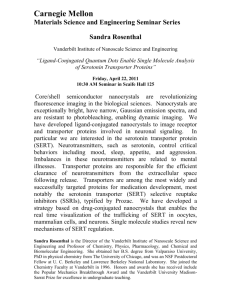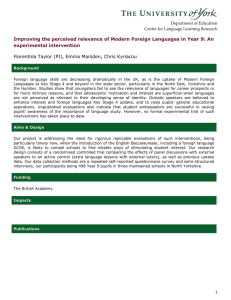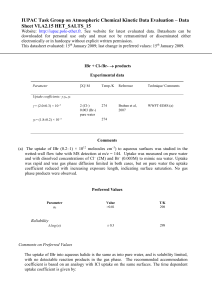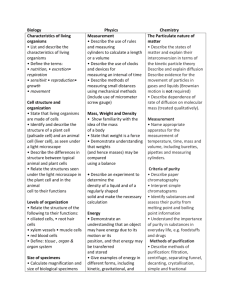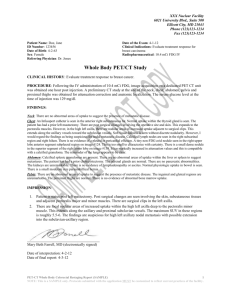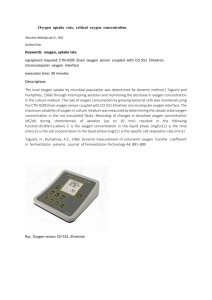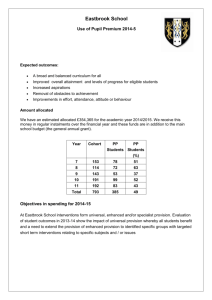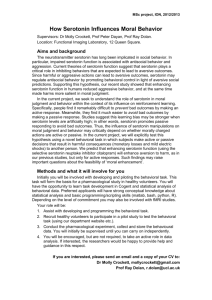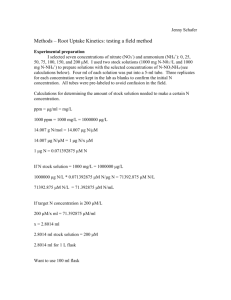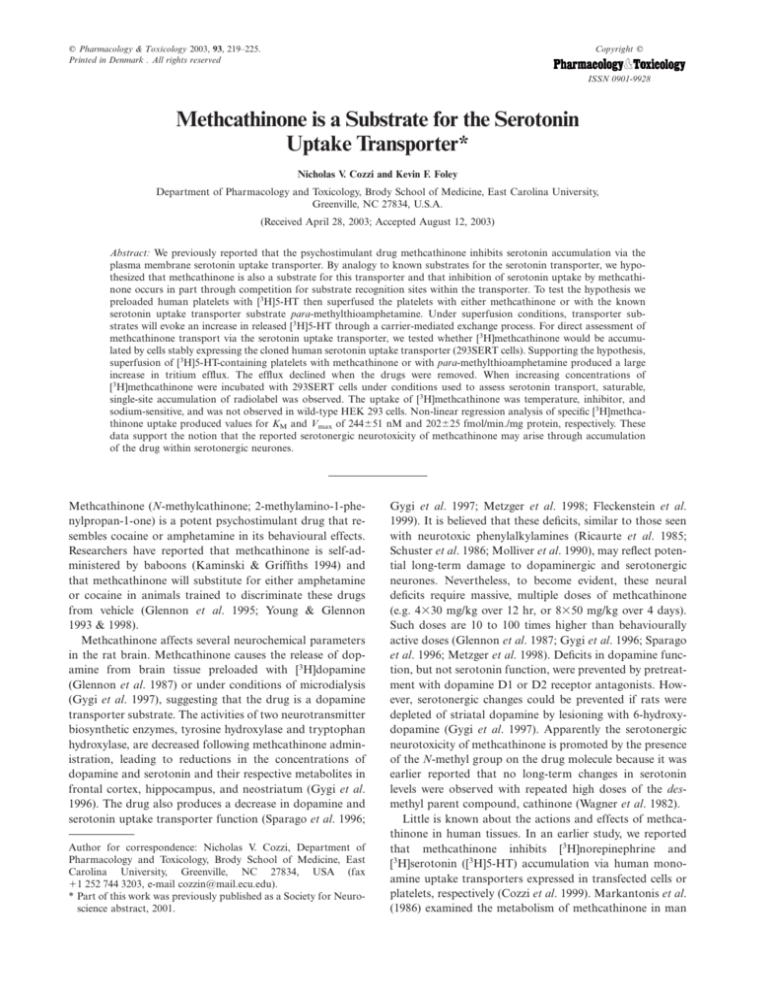
C Pharmacology & Toxicology 2003, 93, 219–225.
Printed in Denmark . All rights reserved
Copyright C
ISSN 0901-9928
Methcathinone is a Substrate for the Serotonin
Uptake Transporter*
Nicholas V. Cozzi and Kevin F. Foley
Department of Pharmacology and Toxicology, Brody School of Medicine, East Carolina University,
Greenville, NC 27834, U.S.A.
(Received April 28, 2003; Accepted August 12, 2003)
Abstract: We previously reported that the psychostimulant drug methcathinone inhibits serotonin accumulation via the
plasma membrane serotonin uptake transporter. By analogy to known substrates for the serotonin transporter, we hypothesized that methcathinone is also a substrate for this transporter and that inhibition of serotonin uptake by methcathinone occurs in part through competition for substrate recognition sites within the transporter. To test the hypothesis we
preloaded human platelets with [3H]5-HT then superfused the platelets with either methcathinone or with the known
serotonin uptake transporter substrate para-methylthioamphetamine. Under superfusion conditions, transporter substrates will evoke an increase in released [3H]5-HT through a carrier-mediated exchange process. For direct assessment of
methcathinone transport via the serotonin uptake transporter, we tested whether [3H]methcathinone would be accumulated by cells stably expressing the cloned human serotonin uptake transporter (293SERT cells). Supporting the hypothesis,
superfusion of [3H]5-HT-containing platelets with methcathinone or with para-methylthioamphetamine produced a large
increase in tritium efflux. The efflux declined when the drugs were removed. When increasing concentrations of
[3H]methcathinone were incubated with 293SERT cells under conditions used to assess serotonin transport, saturable,
single-site accumulation of radiolabel was observed. The uptake of [3H]methcathinone was temperature, inhibitor, and
sodium-sensitive, and was not observed in wild-type HEK 293 cells. Non-linear regression analysis of specific [3H]methcathinone uptake produced values for KM and Vmax of 244∫51 nM and 202∫25 fmol/min./mg protein, respectively. These
data support the notion that the reported serotonergic neurotoxicity of methcathinone may arise through accumulation
of the drug within serotonergic neurones.
Methcathinone (N-methylcathinone; 2-methylamino-1-phenylpropan-1-one) is a potent psychostimulant drug that resembles cocaine or amphetamine in its behavioural effects.
Researchers have reported that methcathinone is self-administered by baboons (Kaminski & Griffiths 1994) and
that methcathinone will substitute for either amphetamine
or cocaine in animals trained to discriminate these drugs
from vehicle (Glennon et al. 1995; Young & Glennon
1993 & 1998).
Methcathinone affects several neurochemical parameters
in the rat brain. Methcathinone causes the release of dopamine from brain tissue preloaded with [3H]dopamine
(Glennon et al. 1987) or under conditions of microdialysis
(Gygi et al. 1997), suggesting that the drug is a dopamine
transporter substrate. The activities of two neurotransmitter
biosynthetic enzymes, tyrosine hydroxylase and tryptophan
hydroxylase, are decreased following methcathinone administration, leading to reductions in the concentrations of
dopamine and serotonin and their respective metabolites in
frontal cortex, hippocampus, and neostriatum (Gygi et al.
1996). The drug also produces a decrease in dopamine and
serotonin uptake transporter function (Sparago et al. 1996;
Author for correspondence: Nicholas V. Cozzi, Department of
Pharmacology and Toxicology, Brody School of Medicine, East
Carolina University, Greenville, NC 27834, USA (fax
π1 252 744 3203, e-mail cozzin/mail.ecu.edu).
* Part of this work was previously published as a Society for Neuroscience abstract, 2001.
Gygi et al. 1997; Metzger et al. 1998; Fleckenstein et al.
1999). It is believed that these deficits, similar to those seen
with neurotoxic phenylalkylamines (Ricaurte et al. 1985;
Schuster et al. 1986; Molliver et al. 1990), may reflect potential long-term damage to dopaminergic and serotonergic
neurones. Nevertheless, to become evident, these neural
deficits require massive, multiple doses of methcathinone
(e.g. 4¿30 mg/kg over 12 hr, or 8¿50 mg/kg over 4 days).
Such doses are 10 to 100 times higher than behaviourally
active doses (Glennon et al. 1987; Gygi et al. 1996; Sparago
et al. 1996; Metzger et al. 1998). Deficits in dopamine function, but not serotonin function, were prevented by pretreatment with dopamine D1 or D2 receptor antagonists. However, serotonergic changes could be prevented if rats were
depleted of striatal dopamine by lesioning with 6-hydroxydopamine (Gygi et al. 1997). Apparently the serotonergic
neurotoxicity of methcathinone is promoted by the presence
of the N-methyl group on the drug molecule because it was
earlier reported that no long-term changes in serotonin
levels were observed with repeated high doses of the desmethyl parent compound, cathinone (Wagner et al. 1982).
Little is known about the actions and effects of methcathinone in human tissues. In an earlier study, we reported
that methcathinone inhibits [3H]norepinephrine and
[3H]serotonin ([3H]5-HT) accumulation via human monoamine uptake transporters expressed in transfected cells or
platelets, respectively (Cozzi et al. 1999). Markantonis et al.
(1986) examined the metabolism of methcathinone in man
220
NICHOLAS V. COZZI AND KEVIN F. FOLEY
and Russian scientists have reported visceral and vascular
pathologies in methcathinone users (Mamrova et al. 2001;
Pigolkin Iu & Sherstiuk 1996). McCann et al. (1998) reported that humans with a history of methcathinone use
exhibited decreased densities of dopamine uptake transporters as estimated by positron emission tomography, suggesting that methcathinone is toxic to dopamine neurones
in human users.
If methcathinone-induced neurotoxicity relies on the
same mechanism reported for other neurotoxic phenylalkylamines, then transport of methcathinone into the neurone is a necessary first step in the production of neurotoxicity. The evidence that methcathinone is a substrate for
dopamine transporters in rats would seem to support this
mechanism at dopaminergic neurones. One of the goals of
the present study was to determine whether methcathinone
was also a substrate for the serotonin transporter. We hypothesized that methcathinone is a substrate for the serotonin
transporter and we tested this hypothesis and evaluated the
kinetic parameters of methcathinone uptake via the serotonin transporter expressed in a heterologous cell line.
A serotonin transporter substrate will evoke the release
of stored cytosolic serotonin through a transporter-mediated exchange mechanism (Rudnick 1997). The ability of
a drug to elicit serotonin release is thus a diagnostic criterion for a serotonin transporter substrate. To test the hypothesis that methcathinone is a substrate for the serotonin
transporter, we examined drug effects in human platelets
and in cells transfected with the cloned human serotonin
uptake transporter. We preloaded human platelets with
[3H]5-HT and superfused them with methcathinone as an
initial screen to see if we could observe drug-evoked [3H]5HT release. We also applied the known serotonin releaser
para-methylthioamphetamine (Huang et al. 1992; Gobbi et
al. 2002) as a positive control. An increase in the amount
of tritium released was taken as evidence that the superfused drug is a serotonin transporter substrate. For direct assessment of methcathinone transport via the serotonin uptake transporter and to determine KM and Vmax
values, we tested whether [3H]methcathinone would be accumulated by wild-type human embryonic kidney 293
(HEK 293) cells or by HEK 293 cells stably expressing the
cloned human serotonin uptake transporter (293SERT
cells) under a variety of conditions.
Materials and Methods
Drugs and reagents. Racemic methcathinone hydrochloride for
[3H]5-HT release experiments was synthesized from (∫)ephedrine
as described by Zhingel et al. (1991). For direct assessment of
methcathinone uptake, we synthesized racaemic [3H]methcathinone
with a specific activity of 80 Ci/mmol in two steps from phenylpropanolamine as previously reported (Cozzi & Ruoho 1998). Briefly,
phenylpropanolamine was oxidized to cathinone using potassium
permanganate in acetic acid. The cathinone produced was then Nmethylated with [3H]methyl iodide in a mixture of toluene and
methanol. The product was purified by reverse-phase HPLC to give
[3H]methcathinone
(2-[3H]methylamino-1-phenylpropan-1-one).
Racaemic para-methylthioamphetamine hydrochloride was syn-
thesized by Dr. Aaron Monte (University of Wisconsin-LaCrosse).
Physical and chemical analytical data for all the synthesized compounds were consistent with the expected structures. [3H]5-HT (specific activityΩ27.5 Ci/mmol) was purchased from New England Nuclear (Boston, MA, USA). Cell culture medium and antibiotics were
obtained from Life Technologies (Gaithersburg, MD, USA). Foetal
bovine serum was purchased from Hyclone (Logan, UT, USA). Pargyline, buffer salts, and miscellaneous chemicals were acquired from
Aldrich Chemical (Milwaukee, WI, USA).
Drug-evoked [3H]5-HT release. Outdated human platelets were obtained from the blood bank at Pitt County Memorial Hospital,
Greenville, NC, USA. Platelets from 10 donors were pooled, dimethylsulfoxide was added to 10% volume, and 6 ml aliquots were
stored frozen at ª80 æ until use. To assess drug-evoked [3H]5-HT
release, an aliquot of frozen platelets was thawed and suspended in
10 ml ice-cold Krebs-Ringer-HEPES (KRH) buffer as previously
described (Cozzi & Foley 2002). The KRH buffer contained the
following ingredients: 124.0 mM NaCl, 2.9 mM KCl, 1.3 mM
MgSO4, 1.2 mM KH2PO4, 2.4 mM CaCl2, 5.2 mM d-glucose, 25.0
mM HEPES, 0.1 mM sodium ascorbate, 0.1 mM pargyline. The
buffer was adjusted to pH 7.4 with 5M NaOH. A 5.1 ml aliquot of
[3H]5-HT (39.2 mM stock solution) was added to the platelet suspension to give a final concentration of 20 nM. The platelets were
then incubated at 37 æ for 20 min. with shaking to allow neurotransmitter uptake. After the labeling incubation, 250 ml aliquots of the
platelet suspension were transferred to each of 9 superfusion
chambers of a superfusion apparatus (Brandel model SF-12) for
triplicate determinations of spontaneous release, methcathinoneevoked release, or para-methylthioamphetamine-evoked release. The
cell suspensions were retained in the superfusion chambers with
Whatman GF/B filter disks. The platelets were superfused with 37 æ
KRH at a rate of 0.5 ml/min. for a 20 min. wash-out period to
achieve a basal level of spontaneous [3H]5-HT release. Following
the washout period, 10 serial 2 min. (1 ml) superfusate fractions
were collected directly into plastic liquid scintillation vials. At the
end of the experiment the glass fiber filters containing the platelets
were also placed into scintillation vials containing 1 ml KRH buffer.
Scintillation cocktail was added (4 ml; ScintiSafe 30%, Fischer
Scientific, Pittsburgh, PA, USA) to all the vials and the vials were
sealed and vortexed. Radioactivity was measured using a Packard
Tri-Carb 2200CA liquid scintillation counter.
To test the effects of methcathinone and para-methylthioamphetamine on [3H]5-HT release, the drugs were introduced into some of
the superfusion chambers at a concentration of 10 mM in KRH
during fractions 3 and 4. The amount of tritium released in the
presence of drugs was compared to the amount released in the absence of drugs and is expressed as percent released. Percent released
for any fraction is calculated by dividing the amount of tritium
released (dpm) during that fraction by the total platelet tritium
present at the start of that fraction collection period and multiplying by 100. The platelet tritium content at the start of a collection
period is the sum of the tritium released during that collection
period, all subsequent collection periods, and the glass fiber filter
tritium content at the end of the experiment.
Cell-specific [3H]methcathinone uptake. To directly assess whether
methcathinone is a serotonin uptake transporter substrate we added
[3H]methcathinone to 293SERT cells (generously supplied by Dr.
Randy Blakely, Vanderbilt University) and to wild-type HEK 293
cells (American Type Culture Collection, Rockville, MD, USA)
under several conditions known to affect serotonin uptake transporter function. 293SERT cells are identical to HEK 293 cells except they stably express the human serotonin uptake transporter.
293SERT cells were maintained in a humidified atmosphere (5%
CO2 in air) in selective culture medium containing Dulbecco’s
Modified Eagle’s Medium (DMEM), 10% foetal bovine serum, and
antibiotics (100 U/ml penicillin, 100 mg/ml streptomycin, 100 mg/ml
geneticin). The wild-type HEK 293 cells were maintained in the
METHCATHINONE IS A SEROTONIN TRANSPORTER SUBSTRATE
same medium minus geneticin. The ability of the cells to accumulate
[3H]methcathinone was measured under the following conditions:
at 37 æ, at 0 æ, in the presence of fluoxetine, or in sodium-free buffer.
For uptake assays, 6¿100-mm dishes of confluent 293SERT or
HEK 293 cells were washed with ice-cold KRH buffer then dislodged with a cell scraper. Cells were suspended in ice-cold KRH
or in sodium-free KRH (KRH buffer with an isoosmotic concentration of TRIS hydrochloride substituting for NaCl) by gentle pipeting. Triplicate 980 ml aliquots of the cell suspension, adjusted to
contain 300 mg protein/aliquot, were added to test tubes on ice.
Protein concentration was determined by the method of Bradford
(1976). After adding the cell suspension, 10 mL KRH (for ‘‘37 æ’’
and ‘‘0 æ’’ determinations), 10 ml of 10 mM fluoxetine hydrochloride
(for ‘‘FLX’’ determinations; final concentration, 100 mM), or 10 ml
of sodium-free KRH (for ‘‘ªNaπ’’ assays) was added to the appropriate tubes. All tubes were preincubated in a shaking water bath
at 37 æ for 10 min., then returned to the ice-bath for 10 min. To
initiate uptake, 10 ml of 1 mM [3H]methcathinone solution was
added to each tube (final concentration, 10 nM) and all tubes except
0 æ tubes were again incubated in the 37 æ shaking water bath. Uptake was allowed to proceed for 10 min. before the test tubes were
returned to the ice-bath. The assay tubes were filtered, processed,
and counted using liquid scintillation spectrophotometry as described above. Data from 3-5 experiments were collected and transformed from dpm to fmol/min./mg protein based upon the specific
activity (80 Ci/mmol) of the [3H]methcathinone used.
Cell-specific [3H]5-HT uptake. To confirm that 293SERT cells, but
not HEK 293 cells, express functional serotonin transporters, experiments were conducted as described above except [3H]5-HT was
221
used as the transporter substrate. Cells were incubated with 10 nM
[3H]5-HT under several conditions (‘‘37 æ’’, ‘‘0 æ’’, ‘‘FLX’’), then filtered and worked-up as described above.
Kinetic parameters of [3H]methcathinone uptake. To determine KM
and Vmax values for methcathinone accumulation into 293SERT
cells, we incubated cells with increasing concentrations of
[3H]methcathinone under conditions used to assess serotonin uptake. 293SERT cells were grown and harvested as described above
and suspended in ice-cold KRH at a concentration of 612 mg protein/ml. Triplicate 490 ml aliquots of the cell suspension (300 mg
protein/aliquot) were added to test tubes on ice containing either 5
ml KRH (for ‘‘total’’ determinations) or 5 ml of 10 mM fluoxetine
(for ‘‘non-specific’’ determinations; final concentration 100 mM).
One hundred ¿ solutions of [3H]methcathinone were prepared from
concentrated stock solution, then 5 ml of these working solutions
were added to test tubes to give final concentrations ranging from
10 nM to 320 nM. The assay tubes were transferred to the 37 æ
shaking water bath to initiate uptake. After 10 min., the tubes were
returned to the ice-bath, 3 ml ice-cold KRH was added, and the
contents were vacuum filtered, washed, and counted as described
above. Non-specific dpm were subtracted from total dpm to calculate specific uptake. Data were transformed from dpm to fmol/min./
mg protein. Data from 2–7 experiments per concentration were
combined and used for curve fitting. Data were fitted using commercial computer software (GraphPad Prism, San Diego, CA,
USA).
Statistics. All values are expressed as the mean∫standard error of
the mean (S.E.M.). Pairwise comparisons of [3H]methcathinone up-
Fig. 1. Drug-evoked release of [3H]5-HT from superfused human platelets. Platelets were preloaded with [3H]5-HT, then superfused with
Krebs-Ringer-HEPES buffer containing pargyline and ascorbate for a 20 min. washout period followed by a 20 min. fraction collection
period. Platelets were superfused in the absence or presence of 10 mM methcathinone (MCAT) or para-methylthioamphetamine (MTA) at a
rate of 0.5 ml/min.; 2 min. fractions were collected and counted. Data were transformed from dpm to percent released.
222
NICHOLAS V. COZZI AND KEVIN F. FOLEY
take between HEK 293 cells and 293SERT cells under each condition of temperature, inhibitor, or ion composition were made
using Student’s t-test. Different treatments in 293SERT cells were
compared to the 37 æ condition by one-way ANOVA followed by
Dunnett’s t-test. P⬍0.05 was considered significant.
Results
Results of the superfusion experiments are shown in fig. 1.
Under superfusion conditions, human platelets preloaded
with [3H]5-HT released a slowly decreasing amount of
radioactivity over time in the absence of drugs. When 10
mM methcathinone was added to the superfusion buffer
during fractions 3 and 4, a large increase in the efflux of
tritium was observed. Para-methylthioamphetamine also
increased the amount of radioactivity released by the superfused platelets, though not to the same extent as methcathinone (fig. 1). After the drug-containing buffers were
switched back to drug-free buffer during fraction 5 and
thereafter, the amount of released tritium declined and
reached control levels by the end of the experiment.
Before conducting uptake experiments with [3H]methcathinone, we confirmed that 293SERT cells, but not HEK
293 cells, take up [3H]5-HT and that this uptake is temperature sensitive and is blockable by fluoxetine (data not
shown). Cell-specific accumulation of [3H]methcathinone is
shown in fig. 2. 293SERT cells accumulate [3H]methcathi-
Fig. 2. Cell-specific accumulation of [3H]methcathinone. 293SERT
cells or HEK 293 cells were incubated with 10 nM [3H]methcathinone for 10 min. under various conditions known to affect serotonin uptake transporter activity. For sodium-free conditions, an
equimolar concentration of TRIS HCl was substituted for NaCl in
the assay buffer. Data from 3–5 experiments, each performed in
triplicate, were transformed from dpm to fmol/min./mg protein.
293SERT cells, but not wild-type HEK 293 cells, accumulate
[3H]methcathinone and this accumulation is temperature-sensitive,
is inhibited by fluoxetine, and is sodium-dependent. All treatments
in the 293SERT cells differed from the 37 æ value at P⬍0.05 (Dunnett’s t-test).
none and this accumulation is temperature-sensitive, is inhibited by fluoxetine, and is sodium-dependent. HEK 293
cells, on the other hand, did not store [3H]methcathinone
under any of the test conditions. Specific [3H]methcathinone uptake at 37 æC, defined as uptake in 293SERT cells
minus uptake in HEK 293 cells, was 45.0 fmol/min./mg protein. All treatments in the 293SERT cells differed from the
37 æ value at P⬍0.05 (Dunnett’s t-test). An association of
[3H]methcathinone with 293SERT cells, but not HEK 293
cells, was observed under the ‘‘0 æ’’ and ‘‘fluoxetine’’ treatment conditions (P⬍0.01; Student’s t-test). This was eliminated by removing sodium ions from the incubation medium.
Serotonin transporter-mediated uptake of [3H]methcathinone was further characterized by incubating 293SERT
cells with concentrations of [3H]methcathinone ranging
from 10 nM to 320 nM in the absence and presence of
fluoxetine. After subtracting fluoxetine-defined non-specific
radioactivity, non-linear regression analysis revealed that
[3H]methcathinone accumulation was saturable and was
best represented by a single-site model (fig. 3). The nonlinear regression coefficients for KM and Vmax were 244∫51
nM and 202∫25 fmol/min./mg protein, respectively. Data
were also transformed for display as a double-reciprocal
plot (fig. 3).
Discussion
Drugs acting at the serotonin uptake transporter can be
broadly classified as non-substrate uptake inhibitors such
as fluoxetine or substrate analogues such as 3,4-methylenedioxymethamphetamine (MDMA). The former compounds prevent serotonin uptake but are not themselves
transported into the cell. Substrate analogues, on the other
hand, are capable of being translocated across the cell membrane in place of serotonin and thereby inhibit serotonin
uptake by competing for the limited number of transport
proteins in a cell. These drugs also cause the release of cytosolic serotonin through a serotonin uptake transporter-mediated exchange mechanism (Rudnick 1997). We previously
reported that methcathinone inhibits [3H]5-HT uptake into
human platelets (Cozzi et al. 1999), but under those experimental conditions we could not distinguish whether the
drug was a pure uptake inhibitor or whether it was a substrate for the serotonin uptake transporter. To answer this
question and to further elucidate the mechanism of action
of methcathinone we tested the hypothesis that methcathinone is a substrate for the serotonin uptake transporter.
Human platelets contain serotonin transporter proteins
and are a long-accepted model for serotonin transport
across the cell membrane. After preloading human platelets
with [3H]5-HT and then superfusing them with 10 mM
methcathinone, there was a 3-fold peak increase in the
amount of radioactivity released into the superfusate (fig.
1). These results are consistent with the hypothesis that
methcathinone is a serotonin uptake transporter substrate
because under the experimental conditions described, if a
substrate is present in the superfusion buffer, it will be taken
METHCATHINONE IS A SEROTONIN TRANSPORTER SUBSTRATE
223
Fig. 3. Accumulation of [3H]methcathinone by 293SERT cells. 293SERT cells were incubated for 10 min. with increasing concentrations of
[3H]methcathinone under conditions used to assess neurotransmitter uptake. Data are the mean of 2–7 experiments per concentration, each
performed in triplicate. Non-specific uptake was defined by 100 mM fluoxetine. Specific uptake was saturable and the data were best fitted,
using non-linear regression, to a single-site model. For calculation of Vmax, data were converted from dpm to fmol/min./mg protein based
upon the specific activity (80 Ci/mmol) of the [3H]methcathinone used. Left panel: saturation isotherm; KMΩ244∫51 nM, VmaxΩ202∫25
fmol/min./mg protein. Right panel: double reciprocal plot of specific uptake data.
up by the serotonin transporter and cause the release of
[3H]5-HT already present in the platelets through transporter-mediated exchange. As expected, when para-methylthioamphetamine was added to the superfusion buffer there
was also an increase in tritium efflux. This result confirms
previous reports that para-methylthioamphetamine is a
serotonin uptake transporter substrate and serotonin-releasing agent (Huang et al. 1992; Scorza et al. 1999; Gobbi
et al. 2002).
To further characterize methcathinone as a serotonin uptake transporter substrate we studied its accumulation into
wild-type HEK 293 cells and into 293SERT cells under conditions known to affect serotonin uptake transporter function. The use of a transfected cell line to assess [3H]methcathinone uptake avoids the potentially confounding effects
on KM and Vmax caused by dopamine and norepinephrine
uptake mechanisms which exist in platelets (Abrams & Solomon 1969; Dean & Copolov 1989). We first confirmed that
[3H]5-HT uptake was cell-specific. We then examined
[3H]methcathinone accumulation under several conditions
known to affect serotonin uptake transporter function. We
also incubated 293SERT cells with increasing concentrations of [3H]methcathinone to determine KM and Vmax
values for transport. 293SERT cells, but not HEK 293 cells,
stored [3H]5-HT (data not shown) or [3H]methcathinone
(fig. 2) under physiological conditions. Treating the HEK
293 data as non-specific, uptake of [3H]methcathinone into
293SERT cells was about 63% specific (45.0 fmol/min./mg
protein). When 293SERT cells were incubated at 0 æ, specific
uptake was reduced about 46% compared to the 37 æ condition (P⬍0.05) but was not completely abolished compared
to the HEK 293 control cells (P⬍0.01). The inhibition of
uptake by cold temperatures is thus not as robust as we
have come to expect from our previous work. The remaining radioactivity could represent binding of [3H]methcathinone to the serotonin uptake transporter, even though
transport itself is inhibited by cold temperatures. When
293SERT cells were incubated with [3H]methcathinone at
37 æ in the presence of fluoxetine or in sodium-free buffer,
the tritium associated with the cells was substantially reduced (P⬍0.01). Under these conditions, the amount of
radioligand was not statistically different from the amount
of radioligand observed in the non-transfected HEK 293
cells (fig. 2). Together, these data show that [3H]methcathinone uptake is cell-specific and that methcathinone exhibits
properties consistent with a serotonin uptake transporter
substrate.
Kinetic constants for [3H]methcathinone intake by
224
NICHOLAS V. COZZI AND KEVIN F. FOLEY
293SERT cells were derived from non-linear regression
analysis of specific [3H]methcathinone uptake as increasing
concentrations of the radioligand were added to the cell suspensions (fig. 3). The data fit significantly better to a onesite model as compared to a two-site model and the double
reciprocal transformation supports this conclusion (fig. 3).
Previously, we reported an IC50 value for methcathinone
inhibition of [3H]5-HT uptake into human platelets of 35
mM (Cozzi et al. 1999). The present study reports a KM for
[3H]methcathinone uptake of 244 nM in 293SERT cells.
The different values for IC50 and KM may reflect differences
in transport kinetics between serotonin and methcathinone
or between native platelets and transfected cells or differences between the mechanism of competitive uptake inhibition and the mechanism of translocation itself. If, as
seems likely, intermediate conformational states of the
transporter occur as part of the translocation process, the
intermediate states will have their own associated rate constants for interconversion between states. Under these conditions transport will not follow simple Michelis-Menten
kinetics and KM will not equal the equilibrium dissociation
constant implied by the IC50 (Fersht 1985). Various kinetic
constants have been reported for the uptake of serotonin
itself into 293SERT cells. For example, the KM and Vmax
values for [3H]5-HT uptake into 293SERT cells have been
reported to range from 260 to 600 nM and from 11.9 to
1377 pmol/min./106 cells, respectively (Qian et al. 1997; Sitte
et al. 2001). The range of reported KM and Vmax values
apparently reflects variations in serotonin uptake transporter expression and activity as cells are maintained in culture for extended periods.
Several research groups have reported that methcathinone produces decreases in dopamine and serotonin
markers in rat brain (Gygi et al. 1996 & 1997; Sparago et
al. 1996; Metzger et al. 1998; Fleckenstein et al. 1999). If
these decreases result from the same mechanism responsible
for the neurotoxic effects of related drugs such as methamphetamine, para-chloroamphetamine, and MDMA, then
a key step in methcathinone-induced neurotoxicity is transport of the drug into the cell via the plasma membrane
monoamine uptake transporters. Although evidence exists
that methcathinone is a substrate for the dopamine transporter (Glennon et al. 1987; Gygi et al. 1997), no data existed for similar activity at the serotonin uptake transporter
prior to this report. Our results indicate that methcathinone
is a substrate for the serotonin uptake transporter and extend our understanding of the mechanism of action of this
psychostimulant drug. Neuronal uptake of methcathinone
by the serotonin uptake transporter may be an essential step
in the production of serotonergic neurotoxicity. If so,
blocking the serotonin uptake transporter with drugs such
as fluoxetine may reduce the potential for serotonin neurotoxicity.
Acknowledgements
We thank Jacqueline McKeel for excellent technical assistance. This work was supported, in part, with a grant
from the National Alliance for Research on Schizophrenia
and Depression (NVC) and by a grant from the East
Carolina University Medical Foundation (KFF).
References
Abrams, W. B. & H. M. Solomon: The human platelet as a pharmacologic model for the adrenergic neuron. The uptake and release
of norepinephrine. Clin. Pharmacol. Ther. 1969, 10, 702–709.
Bradford, M. M.: A rapid and sensitive method for the quantitation
of microgram quantities of protein utilizing the principle of protein-dye binding. Anal. Biochem. 1976, 72, 248–254.
Cozzi, N. V. & K. F. Foley: Rapid and efficient method for suspending cells for neurotransmitter uptake assays. Biotechniques
2002, 32, 486–492.
Cozzi, N. V. & A. E. Ruoho: Radiosynthesis of [3H]methcathinone,
an inhibitor of monoamine reuptake transporters. J. Labelled
Cpd. Radiopharm. 1998, 41, 927–933.
Cozzi, N. V., M. K. Sievert, A. T. Shulgin, P. Jacob III & A. E.
Ruoho: Inhibition of plasma membrane monoamine transporters
by b-ketoamphetamines. Eur. J. Pharmacol. 1999, 381, 63–69.
Dean, B. & D. L. Copolov: Dopamine uptake by the human platelet: effects of dopamine receptor agonists. Eur. J. Pharmacol.
1989, 173, 165–169.
Fersht, A.: Enzyme structure and mechanism, 2nd ed. W. H. Freeman and Company, New York, NY, 1985.
Fleckenstein, A. E., H. M. Haughey, R. R. Metzger, J. M. Kokoshka, E. L. Riddle, J. E. Hanson, J. W. Gibb & G. R. Hanson:
Differential effects of psychostimulants and related agents on
dopaminergic and serotonergic transporter function. Eur. J.
Pharmacol. 1999, 382, 45–49.
Glennon, R. A., R. Young, B. R. Martin & T. A. Dal Cason:
Methcathione (‘‘Cat’’): an enantiomeric potency comparison.
Pharmacol. Biochem. Behav. 1995, 50, 601–606.
Glennon, R. A., M. Yousif, N. Naiman & P. Kalix: Methcathinone:
a new and potent amphetamine-like agent. Pharmacol. Biochem.
Behav. 1987, 26, 547–551.
Gobbi, M., M. Moia, L. Pirona, I. Ceglia, M. Reyes-Parada, C.
Scorza & T. Mennini: p-Methylthioamphetamine and 1-(m-chlorophenyl)piperazine, two non- neurotoxic 5-HT releasers in vivo,
differ from neurotoxic amphetamine derivatives in their mode of
action at 5-HT nerve endings in vitro. J. Neurochem. 2002, 82,
1435–1443.
Gygi, M. P., A. E. Fleckenstein, J. W. Gibb & G. R. Hanson: Role
of endogenous dopamine in the neurochemical deficits induced
by methcathinone. J. Pharmacol. Exp. Therap. 1997, 283, 1350–
1355.
Gygi, M. P., J. W. Gibb & G. R. Hanson: Methcathinone: an initial
study of its effects on monoaminergic systems. J. Pharmacol.
Exp. Therap. 1996, 276, 1066–1072.
Huang, X., D. Marona-Lewicka & D. E. Nichols: p-Methylthioamphetamine is a potent new non-neurotoxic serotonin-releasing
agent. Eur. J. Pharmacol. 1992, 229, 31–38.
Kaminski, B. J. & R. R. Griffiths: Intravenous self-injection of
methcathinone in the baboon. Pharmacol. Biochem. Behav. 1994,
47, 981–983.
Mamrova, G. P., B. V. Sherstiuk, D. V. Bogomolov, M. Ozdamirova
Iu & A. Nikolkina Iu: [Epidemiologic analysis of ephedrone substance abuse in the Primorye territory]. Sud. Med. Ekspert. 2001,
44, 30–32.
Markantonis, S. L., A. Kyroudis & A. H. Beckett: The stereoselective metabolism of dimethylpropion and monomethylpropion.
Biochem. Pharmacol. 1986, 35, 529–532.
McCann, U. D., D. F. Wong, F. Yokoi, V. Villemagne, R. F. Dannals & G. A. Ricaurte: Reduced striatal dopamine transporter
density in abstinent methamphetamine and methcathinone users:
METHCATHINONE IS A SEROTONIN TRANSPORTER SUBSTRATE
evidence from positron emission tomography studies with
[11C]WIN-35,428. J. Neurosci. 1998, 18, 8417–8422.
Metzger, R. R., G. R. Hanson, J. W. Gibb & A. E. Fleckenstein:
3-4-Methylenedioxymethamphetamine-induced acute changes in
dopamine transporter function. Eur. J. Pharmacol. 1998, 349,
205–210.
Molliver, M. E., U. V. Berger, L. A. Mamounas, D. C. Molliver, E.
O’Hearn & M. A. Wilson: Neurotoxicity of MDMA and related
compounds: anatomic studies. Ann. N. Y. Acad. Sci. 1990, 600,
649–661; discussion 661–664.
Pigolkin Iu, I. & B. V. Sherstiuk: [The histopathology of ephedrone
drug abuse]. Sud. Med. Ekspert. 1996, 39, 26–28.
Qian, Y., A. Galli, S. Ramamoorthy, S. Risso, L. J. DeFelice & R.
D. Blakely: Protein kinase C activation regulates human serotonin transporters in HEK-293 cells via altered cell surface expression. J. Neurosci. 1997, 17, 45–57.
Ricaurte, G., G. Bryan, L. Strauss, L. Seiden & C. Schuster: Hallucinogenic amphetamine selectively destroys brain serotonin nerve
terminals. Science 1985, 229, 986–988.
Rudnick, G.: Mechanisms of biogenic amine neurotransmitter
transporters. In: Neurotransmitter transporters: structure, function, and regulation. Ed.: M. E. Reith. Humana Press, Totowa,
NJ, 1997, pp. 73–100.
Schuster, C. R., M. Lewis & L. S. Seiden: Fenfluramine: neurotoxicity. Psychopharmacol. Bull. 1986, 22, 148–151.
Scorza, C., R. Silveira, D. E. Nichols & M. Reyes-Parada: Effects
225
of 5-HT-releasing agents on the extracellullar hippocampal 5-HT
of rats. Implications for the development of novel antidepressants
with a short onset of action. Neuropharmacology 1999, 38, 1055–
1061.
Sitte, H. H., B. Hiptmair, J. Zwach, C. Pifl, E. A. Singer & P. Scholze: Quantitative analysis of inward and outward transport rates
in cells stably expressing the cloned human serotonin transporter:
inconsistencies with the hypothesis of facilitated exchange diffusion. Mol. Pharmacol. 2001, 59, 1129–1137.
Sparago, M., J. Wlos, J. Yuan, G. Hatzidimitriou, J. Tolliver, T. A.
Dal Cason, J. Katz & G. Ricaurte: Neurotoxic and pharmacologic studies on enantiomers of the N-methylated analog of cathinone (methcathinone): a new drug of abuse. J. Pharmacol. Exp.
Therap. 1996, 279, 1043–1052.
Wagner, G. C., K. Preston, G. A. Ricaurte, C. R. Schuster & L. S.
Seiden: Neurochemical similarities between d,l-cathinone and damphetamine. Drug Alcohol Depend. 1982, 9, 279–284.
Young, R. & R. A. Glennon: Cocaine-stimulus generalization to
two new designer drugs: methcathinone and 4-methylaminorex.
Pharmacol. Biochem. Behav. 1993, 45, 229–231.
Young, R. & R. A. Glennon: Discriminative stimulus effects of S()-methcathinone (CAT): a potent stimulant drug of abuse. Psychopharmacology (Berl) 1998, 140, 250–256.
Zhingel, K. Y., W. Dovensky, A. Crossman & A. Allen: Ephedrone:
2-methylamino-1-phenylpropan-1-one (Jeff). J. Forensic Sci.
1991, 36, 915–920.

